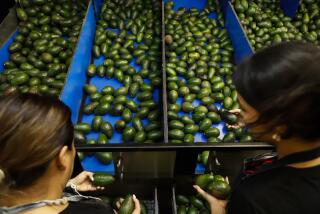International Business : U.S. Ruling a Thorn in Colombian Rose Growers’ Side : Trade: Commerce Department decision imposes punitive anti-dumping levies.
- Share via
BOGOTA, Colombia — This nation’s $100-million-a-year rose industry has been imperiled by a recent American anti-dumping ruling in favor of U.S. growers, Colombian industry representatives say.
Colombian growers, who send an estimated 90% of their production to the American market, say a tentative decision last month by the U.S. Commerce Department could force them to hold back 50% of their rose exports over the next three months and could cost Colombians about 50,000 jobs.
In its decision, the Commerce Department sided with two U.S. industry groups, the U.S. Floral Trade Council and Roses Inc., in finding that Colombian and Ecuadorean producers exported roses at unfairly low prices. In addition to job losses in South America, the Colombians say, the ruling could cost jobs in south Florida among companies that import and distribute Colombian flowers. The department is expected to issue a final ruling in January.
“Most of Colombian rose companies are small and-or highly leveraged and will have a very tough time placing their product in the States with this measure,” said Jack Goldstein, manager of Flora Intercontinental, a flower exporter.
As a result of its ruling, the Commerce Department imposed anti-dumping levies averaging 33.87% on Colombian roses and 50% duties on the Ecuadorean product; it subsequently reduced the Colombian duty to 22.73%. The additional duties could make imported flowers much more expensive than U.S.-grown varieties.
Experts say half the 180 companies that produce roses in Colombia could go out of business if the measure is upheld; that would put out of work thousands of poor women who make up 80% of the labor force in the industry.
Many more U.S. jobs have been lost and greenhouses closed because of low-cost competition from foreign growers, said Jim Krone, executive vice president of Haslett, Mich.-based Roses Inc. “I’m anticipating that the decision will stop the closure of greenhouses across America. This action doesn’t bar anyone from bringing their roses in here. They’ll just have to do it fairly now.”
According to a report by the Floral Trade Council, also based in Haslett, the number of commercial rose growers in the United States fell to 213 last year from 323 in 1971. Foreign imports have risen to 61.7% of the $13-billion U.S. market, from 0.2% in 1973, the report says.
Krone said the U.S. industry declined because growers could not compete with foreign prices.
Colombian flower producers, who supply 57% of the roses sold in the United States, note bitterly that this is the fifth time in the last eight years that American producers have pursued legal actions against them.
While the previous penalties had generally been small--duties ranging from 1% to 5%--the levies, they say, also cost them millions in legal and administrative fees and punished them for competing in the U.S. market.
“This is a typical protectionist attitude in favor of U.S. flower producers who try to compensate for their inefficiencies with duties,” Juana Maria Unda, president of the Colombian Assn. of Flower Exporters, complained to the newspaper El Tiempo.
In the past three years, Colombia’s rose industry has been hurt by winter frosts, a steady revaluation of the peso and a growing world supply that has caused prices to drop an estimated 30%.
Growers here argue that the Commerce Department failed to account for seasonal pricing differences when comparing the prices in the United States and Europe.
They say the agency also ignored the fact that while U.S. sales are usually on consignment, allowing the market to set prices, European sales are usually “fixed order”--that is, for special occasions and at special quality standards.
“If you are realistic and consider that Holland, Mexico, Costa Rica and Guatemala also sell roses to the U.S., you will see the disadvantage that Colombia is at with roses 22% more expensive,” Unda said.
*
Times staff writer Ray Delgado in Los Angeles contributed to this report.
More to Read
Inside the business of entertainment
The Wide Shot brings you news, analysis and insights on everything from streaming wars to production — and what it all means for the future.
You may occasionally receive promotional content from the Los Angeles Times.










